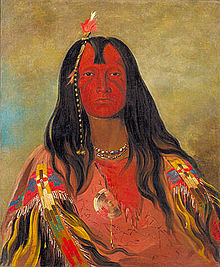Nez Perce (tribe)

No Horn on His Head, a Nez Perce man painted by George Catlin
|
|
| Total population | |
|---|---|
| 3,499 (2010 census) | |
| Regions with significant populations | |
| United States (Idaho) | |
| Languages | |
| English, Nez Perce | |
| Religion | |
| Seven Drum (Walasat), Christianity, other | |
| Related ethnic groups | |
| other Sahaptin peoples |
The Nez Perce /ˌnɛzˈpɜːrs/ (autonym: Niimíipuu in their own language, meaning "the walking people" or "we, the people") are an Indigenous people of the Plateau who have lived on the Columbia River Plateau in the Pacific Northwest region of the United States for a long time.
Members of the Sahaptin language group, the Niimíipuu were the dominant people of the Columbia Plateau for much of that time, especially after acquiring the horses that led them to breed the appaloosa horse in the 18th century.
Prior to "first contact" with Western civilization the Nimiipuu were economically and culturally influential in trade and war, interacting with other indigenous nations in a vast network from the western shores of Oregon and Washington, the high plains of Montana, and the northern Great Basin in southern Idaho and northern Nevada).
After first contact, the name "Nez Perce" was given to the Niimíipuu and the nearby Chinook people by French explorers and trappers. The name means "pierced nose," but only the Chinook used that form of decoration.
...
Wikipedia
